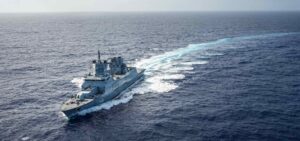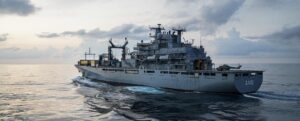No reason to get excited - not even for the Chinese
When a German unit, consisting of the then brand new frigate F 217 "Bayern", the frigate F 207 "Bremen" as well as a supply ship and a tanker, showed a German presence in the waters around China in 1997, the public in Germany took no notice. They felt on friendly terms, and the harbour visit in Shanghai deepened the impression. In 2002, it was the frigates F 209 "Rheinland-Pfalz" and F 218 "Mecklenburg-Vorpommern" that visited the Chinese port of Qingdao, among other places, and on the course the crossed the Taiwan Strait. This had no significance whatsoever; the Chinese PLAN (Peoples Liberation Army Navy), which was still in its infancy, had no reason to antagonise the German Navy. There were visits and invitations, even the then inspector of the navy, Lutz Feld, was with his unit for a time. They travelled through the Taiwan Strait because it is free sea space. Anyone can sail through there, without restriction. Then as now. What did the naval units want in the Indo-Pacific waters? They were on friendly visits to Japan, South Korea and Singapore, among others. An expression of Germany's interest in Asian trading partners, a symbolic presence in the sea areas that are important routes for Germany as a trading nation. In addition, embassies in this part of the world had requested diplomatic voyages by German warships to strengthen relations and maintain contacts. Politically and economically, this was something completely normal and something that other nations did much more intensively than Germany. There were no obstacles or hostilities, only undisciplined groups of fishermen had to be chased away from time to time, as Thorsten Kähler, head of the association in 2002, reports with a grin. A long time and long political developments later, nothing has changed in terms of peaceful German interests.

A paper from the Federal Foreign Office
These interests were set out by the government in 2020 in the so-called "Guidelines on the Indo-Pacific". Under the motto "Germany-Europe-Asia, shaping the 21st century together", the Federal Foreign Office declared to the public that Germany was in favour of a "rules-based order" and that the German Navy would also contribute to this. Signed by the then Foreign Minister Heiko Maas, clearly not by Chancellor Angela Merkel, the aim was to actively participate in the enforcement of the 1982 UN Convention on the Law of the Sea and also in the sanctions against North Korea. The aim was also to strengthen security and defence policy cooperation with partners in the region, including defence policy contacts in the region, including (port) visits and "forms of maritime presence", as the paper states. Just one year later, the frigate "Bayern" left Wilhelmshaven again to realise these intentions of the German government in a practical and present manner. Reports that ranted about "gunboat policy" or mocked the fighting power of the "Bayern" in comparison to the PLAN only showed that the mockingbirds had obviously not read the Foreign Office's work. Or maybe they had, but just couldn't stop sneering. It was the realisation of German interests, which is why they sailed individually and not with the French or British. That might have meant subordinating ourselves to other interests. The question of whether the "Bayern" would sail through the Taiwan Strait or not was unavoidable, because in the meantime China had reacted increasingly aggressively to the passage of foreign warships. China considers the Taiwan Strait (also known as the Formosa Strait in some publications) to be its sovereign territory and is building up a massive threatening posture. The USA, France and Great Britain oppose this behaviour with regular, peaceful passages. No, the "Bayern" did not travel the Strait in 2021. The reason was not concern about China's reaction, because after its friendly invitation to visit a Chinese port, the itinerary no longer allowed it. It can be assumed that the government at the time was rather relieved to receive this invitation. How would it have been dealt with if the Chinese had been kind enough to harbour the crews almost 100 years after the end of the German East Asia Squadron? But let's save ourselves a look at the history book of the German Navy. Even the packs of fishermen were no longer easy to avoid. Their aggressiveness was humorously described by the current inspector Jan Kaack in 2021 with the words "little blue men", although this encounter was no longer as relaxed as it had been 20 years earlier.
The formation, which consists of the frigate F 222 "Baden-Württemberg" and the task force provider A 1412 "Frankfurt am Main", is different. With the same mission as in the past and a clearer international objective, the unit is now sailing through this sea area on its circumnavigation of the globe, as the German Minister of Defence, Boris Pistorius, confirmed this afternoon. The German Navy has a clear political mission, derived from the above-mentioned guidelines, and above all a clear intention: co-operation with Asian partners, joint exercises with the USA, Japan and other nations in the Pacific to strengthen military capabilities and an expression of the determination not to be intimidated by China. At the same time and coordinated as far as possible, the German Air Force also practised in the Indo-Pacific. The joint "Pacific Waves and Pacific Skies" was a strong signal. Whether this can be achieved with the A400M transport aircraft, a few Tornado fighter bombers, Eurofighters, two ships and half a dozen exercises remains to be seen. It is also not about a comparison of weapons, but about a consistent presence. And the fact that the Chinese are impressed - or at least annoyed - can be seen from their warnings. And by the fact that the German ships were completely shadowed by several Chinese naval units. The German men and women were also massively harassed with lasers. The navy is prepared for this with goggles, but why are the Chinese doing this? Do we do the same with Chinese warships in the English Channel, the Great Belt or the Fehmarn Belt? No, of course not, because we are in favour of free sea lanes. And this diplomatic signal is being received in this region. And the navigation of the strait, which was so often discussed beforehand?

Why the strait?
Let's take a look at what this sea area is: It is a stretch of water about 80 to 100 nautical miles (180 kilometres) wide and about 350 nautical miles long between the province of Fujian and the island of Taiwan, with the East China Sea to the north and the South China Sea to the south. The respective coasts of China and Taiwan have 12-mile zones, i.e. their territorial waters. Warships are allowed to sail here because the "Right to peaceful transit" exists. But only peaceful sailing, i.e. no exercises or helicopter missions, submarine diving, weapons training or tactical manoeuvres. This also exists in Europe: the Great Belt belongs to Denmark, but warships are still allowed to sail there, which the Russians make ample use of and the Chinese were also allowed to do so unmolested in 2024. As a foreign nation, you recognise that these are the territorial waters of another state. Back to the Taiwan Strait: Minus the 12-mile zones, this leaves around 55 to 75 nautical miles in the centre that are freely navigable. And free navigation means being able to carry out all forms of military manoeuvres that can be performed in the vastness of an ocean. And for those readers who are just passing by and reading this, but have not previously been involved in seafaring: The Taiwan Strait is not a strait where you can see a land line on the horizon on both sides, as in the Great Belt, which is around 15 nautical miles (25 kilometres) wide. China, although it acceded to the UN Convention on the Law of the Sea in 1986, wants to declare the entire strait its sovereign territory. This is not only internationally illegal, but also somehow ridiculous - as if Denmark were to claim the Baltic Sea for itself. And that is precisely why you have to sail through there to make China realise this absurdity. After all, the waterway is one of the busiest sea trade routes in the world. China in particular, a nation that profits from global trade, should have an interest in its peaceful and relaxed utilisation. And under no circumstances should we act as if it were a territorial sea, because then we would be recognising its status. Check? So we wanted to see pictures of German warships practising and noisily sailing through the area. Our allies and partners want to see these images too, and not just in Asia. If we hadn't done this, it would have been a lasting and almost unbearable loss of face - for Germany. Embarrassing. A rabbit's foot. It would have been better to stay at home.
And why does China see this as a provocation?
That is not relevant. China has to recognise that this is not its territorial sea, just as it crosses other territorial waters with its warships, accepting this fact. Incidentally, China must also accept that this will not change if the Taiwan question will possibly have been resolved - politically or militarily - whatever the case may be. Even then, it will remain international waters. And should China ever close or occupy the strait militarily, China would indirectly recognise that it was previously free, international waters. China has got itself into trouble without need. What the German association did is normal among peaceful states. If we do not keep the "choke points" of international world trade open, prosperity and trade will no longer be possible for all of us.
If you want to know more, we recommend reading this brochure from the US Indo-Pacific Command...
Authors: Schlüter/Stephenson









2 responses
Thank you Holger and Mr Stephenson for this article. It cannot be repeated often enough that China is on the wrong track and that Germany, as a free and democratic trading nation, is dependent on free maritime routes and must regularly express this.
Thank you for this article, which helps to make sense of what is happening. In particular, the references to the Chinese using and claiming international maritime law in other sea areas (keyword Baltic Sea approaches) are very revealing. I would have liked the context of the Indo-Pacific Grand Manoeuvre, in which the German units are participating together with Western and friendly East Asian states, to have been presented in more detail. Nevertheless, many thanks.